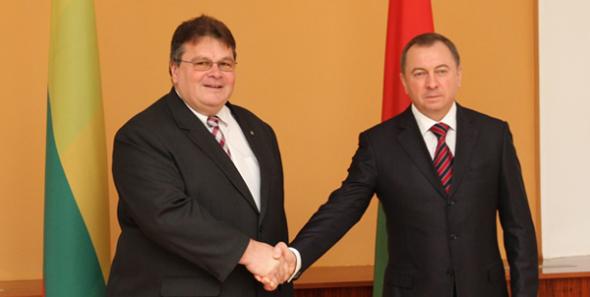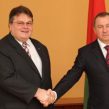
Asymmetric Ties and a Balancing Act
Publication: Eurasia Daily Monitor Volume: 11 Issue: 140
By:

The geopolitical perspective that Belarus is being squeezed between Russia and the European Union remains relevant. New information continues to reveal modest but noticeable attempts to improve Belarus’s relations with the West (see EDM, July 23) as well as the ambivalent role of Russia, Belarus’s most important ally and sponsor.
On Belarus’s western flank, the most notable activity has involved Lithuania and the United States. Lithuanian Minister of Foreign Affairs Linas Linkevicius recently paid a two-day visit to Minsk. In his interview to Belorusskie Novosti, Linkevicius praised Belarus’s “consistent stance with regard to the annexation of South Ossetia and Crimea.” A special topic of current Belarusian-Lithuanian negotiations is the upcoming opening of Lithuanian visa centers in every regional capital of Belarus and of adding 11 new local border crossings between the two countries. The Belarusian side has not yet ratified the earlier signed agreement on small-scale cross-border commuting, but it probably will in the foreseeable future. The opening of the regional visa centers will minimize Belarusian visa applicants’ travel costs. Moreover, the opening of these centers is a compensatory move because, beginning in January 2015, biometric data will be required from all applicants, thus tripling the application processing time (Belorusskie Novosti, July 25).
Regarding ties to the US, three important suggestions were recently made in the July 29 article “How to cut the Gordian knot in the relationships with the United States?” by Arseny Sivitski, who chairs the Minsk-based Center for Strategic and Foreign Policy Research. The first suggestion is to restore both the US embassy in Minsk and the Belarusian embassy in Washington to full capacity. The second suggestion is to reinforce Belarus’s role within the Northern Distribution Network (NDN), a major supply and departure route for the US military in Afghanistan. Sivitsky underscores that Belarus’s tariffs for US military transit are lower than those imposed by other transit countries and suggests that an NDN logistical center should be organized in Belarus along the lines of those in Ulyanovsk, Russia, and Aktau, Kazakhstan. Sivitsky’s third suggestion is to create a non-governmental Belarusian-US advisory board that would research and promote new directions for bilateral relations. Sivitsky admits that bureaucratic procedures in the United States are likely to greatly delay the withdrawal of US sanctions imposed on Belarus. But he believes that the main obstacle to improving bilateral relations is actually the low level of mutual familiarity with the actual processes unfolding in both countries (CSFPS, July 29).
According to information supplied by the Embassy of Belarus in Washington, DC, in 2013, Belarus’s merchandise trade exchange with the US totaled $675.7 million, 95.8 percent of its 2012 value. The reduction was caused by shrinking (by 7.5 percent) US exports to Belarus, whereas Belarus’s exports increased by 25.2 percent. The major Belarusian exports to the US are pipes for the oil and gas industry, optical and measuring equipment, textiles, flax fabric, products of wood processing, and some foods. The major US exports are engines, automobiles, medical equipment and medications. In 2013, the export of services from Belarus to the US accounted for $235.9 million, whereas import was only $60.2 million. The bulk of service exports from Belarus are in the area of software developed by the Hi-Tech Park in Minsk. On January 1, 2014, there were 382 joint ventures and foreign-owned businesses in Belarus financed with US capital. The 2013 scale of new US investment was $168.2 million, including $127.6 million of direct investment. In 2013, General Motors decided to locate its assembly factory in Belarus (Embassy of Belarus, accessed July 30).
On Belarus’s opposite geopolitical flank, the situation is affected by the war in Ukraine. On the one hand, Belarus stands to gain from Russia’s offer to have Belarusian plants produce the several thousand military components (mostly in the areas of lasers, electronics and aircraft) that used to be manufactured by Ukrainian factories jointly with Russian counterparts. In part, Belarus may be enticed into joint ventures with the existing Ukrainian producers, so their output continues to go to Russia, only through Belarus (Svaboda.org, July 27).
On the other hand, however, there is still risk that Belarus may be used by Russia as a bridgehead against the North Atlantic Organization’s (NATO) military consolidation in Poland and the rest of Central Eastern Europe. Currently, Russia’s Ministry of Defense is moving its S-300 air-defense complexes to Belarus (ITAR-TASS, July 10). This westward redeployment is happening in part because Russia is positioning more advanced S-400 systems around Moscow. Nonetheless, in case of any conflagration, those more modern Russian rocket launchers as well as 9K720 Iskanders (mobile theater ballistic missile systems) and Su-34 aircraft—all of which took part in the July 3 military parade in Minsk—can also be deployed in Belarus.
Furthermore, the June 2014 national survey by the Independent Institute for Socio-Economic and Political Studies reinforced earlier evidence (see EDM, June 18) that Belarus is particularly vulnerable to Russian propaganda. Between one half and two-thirds of Belarusians believe in Russian assessments of the situation in Ukraine. For example, 50.9 percent trust that Kyiv’s government is a fascist one; 62.2 percent believe that the annexation of Crimea was a reflection of historical justice; and 65.5 percent believe that a separatist movement in eastern Ukraine is a “popular protest against illegitimate power” (Belorusskie Novosty, July 22).
At the same time, however, Belarus continues to enjoy enthusiastic support of quite a few Russians, particularly from the provinces. A recent article by Kamil Bibersov, a sociologist from the Russian city of Ulyanovsk, depicts Alyaksandr Lukashenka’s Belarus as a society much more prepared for “civilized capitalism” than Russia or Ukraine. This is because in Belarus, the power of oligarchs and social polarization are curbed and corruption is held in check (Belarus Segodnya, July 24). Bibersov’s opinion matches what Mark Almond, an Oxford historian, wrote in The Guardian back in 2006 (The Guardian, March 20, 2006).
Despite its asymmetric economic ties and Soviet legacy, Belarus continues to perform its balancing act between Russia and Europe. But it appears to be more skillful and successful at this than it is given credit for in the Western media.




